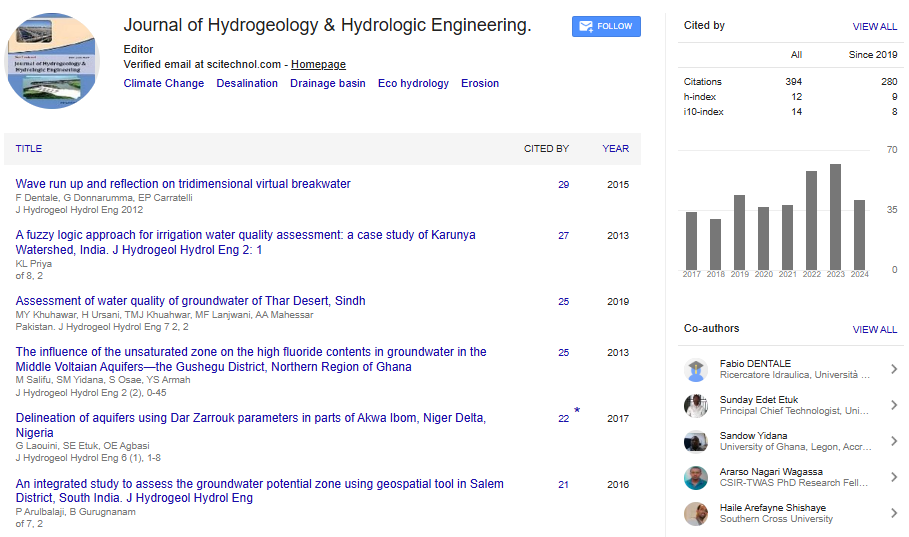Commentary, J Hydrogeol Hydrol Eng Vol: 13 Issue: 4
A Thorough Study of Hydrology Modeling Techniques and Their Practical Applications
Bhumi Budhathoki*
1Department Earth Sciences, University Putra Malaysia, Selangor, Malaysia
*Corresponding Author: Bhumi Budhathoki,
Department Earth Sciences,
University Putra Malaysia, Selangor, Malaysia
E-mail: budhathokib26@gmail.com
Received date: 29 July, 2024, Manuscript No. JHHE-24-149247;
Editor assigned date: 31 July, 2024, PreQC No. JHHE-24-149247 (PQ);
Reviewed date: 14 August, 2024, QC No. JHHE-24-149247;
Revised date: 21 August, 2024, Manuscript No. JHHE-24-149247 (R);
Published date: 29 August, 2024, DOI: 10.4172/2325-9647.1000335
Citation: Budhathoki B (2024) A Thorough Study of Hydrology Modeling Techniques and Their Practical Applications. J Hydrogeol Hydrol Eng 13:4.
Description
Hydrology modeling plays an essential role in understanding and managing water resources, predicting flood risks and analyzing the impacts of land-use changes. These models simulate the movement and distribution of water across different landscapes, enabling scientists, engineers and policymakers to make informed decisions about water management. This article delves into the fundamental principles, methodologies and applications of hydrology modeling, highlighting its significance in modern hydrologic engineering.
Hydrology modeling refers to the mathematical and computational simulation of the water cycle, encompassing processes such as precipitation, infiltration, surface runoff, evapotranspiration and groundwater flow. The models can be used to study both surface water and groundwater systems, making them essential tools in fields like flood forecasting, water quality management and erosion control. There are two main types of hydrology models: Lumped models and distributed models. Lumped models treat an entire watershed as a single unit, averaging out the hydrologic variables across the basin.
These models are simpler and computationally efficient, making them suitable for large-scale or quick assessments. However, they lack spatial detail. On the other hand, distributed models consider the spatial variability of a watershed, dividing it into smaller subunits or grids to capture finer-scale hydrological processes. Though more complex and data-intensive, distributed models offer a more accurate representation of water flow and distribution.
The starting point of most hydrological models is rainfall or snowmelt. Precipitation data, which can be sourced from weather stations or remote sensing, serves as the main input for determining the amount of water entering the system. Once precipitation reaches the surface, some water infiltrates the soil, while the rest contributes to surface runoff. Infiltration models such as the green-ampt method or Horton’s equation are used to estimate the rate at which water penetrates the soil. Runoff models, on the other hand, predict how much of the excess water flows overland into streams and rivers.
This represents the combined process of evaporation and transpiration by plants. Evapotranspiration models, such as the Penman-Monteith equation, help determine how much water is lost to the atmosphere from soil and vegetation. For modeling subsurface water flow, techniques like the finite difference or finite element methods are employed. These models are often integrated with surface water models to simulate the interaction between surface water and groundwater, an essential aspect of comprehensive water resource management.
Hydrology models are indispensable in predicting flood events by simulating how rainfall interacts with a watershed’s topography, soil and vegetation. These models help assess flood risk, design flood control infrastructure and develop early warning systems. By simulating the availability of water in rivers, lakes and aquifers, hydrology models assist in managing water supply for urban, agricultural and industrial purposes. They also play a key role in assessing the impacts of climate change on water availability and distribution.
As urbanization and land use change affect the natural water cycle, hydrology models can predict how alterations in land cover (such as deforestation or urban development) impact runoff, erosion and groundwater recharge. Hydrology models, combined with sediment transport models, help in designing strategies to moderate erosion and sedimentation. This is particularly important for maintaining the health of aquatic ecosystems and protecting infrastructure like dams and reservoirs.
Conclusion
Hydrology modeling has become an indispensable tool for understanding and managing the complex dynamics of water in the environment. From predicting floods to assessing the impacts of landuse changes and managing water resources, these models offer valuable insights for scientists, engineers and policymakers alike. As advancements in computational power and data availability continue, the accuracy and applicability of hydrology models will only improve, paving the way for more sustainable water management practices in the future.
 Spanish
Spanish  Chinese
Chinese  Russian
Russian  German
German  French
French  Japanese
Japanese  Portuguese
Portuguese  Hindi
Hindi 
